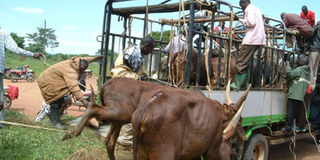Foot and mouth disease spreads to Mpigi

Cattle being loaded onto a waiting truck in Gomba District cattle market recently. Government has imposed a quarantine in neighbouring Mpigi District over foot and mouth disease. PHOTO BY SADAT MBOGO
What you need to know:
Concern. Disease already reported in four other central region districts
Mpigi.
Foot and mouth disease, which has already been reported in four districts in central region, has now spread to Mpigi District.
As a way of containing the highly contagious animal disease, veterinary authorities in the district have slapped a quarantine on the slaughter and sale of meat in the area, movement of animals as well as sharing of watering areas.
“We have so far detected 10 cases of infected animals in each of the seven parishes in Muduuma Sub-county, but measures have been put in place to avoid the spread of disease,” said Mr Reuben Kawagga, the Mpigi District veterinary officer, in an interview at the weekend.
Reports of the outbreak first surfaced in early June in Wakyato, Kinoni and Ngoma sub-counties in Nakaseke District, before emerging in Luweero, Nakasongola and Sembabule districts.
Officials in the four districts banned the movement of animals and reported the ban to the Agriculture ministry, though the disease continued spreading.
Dr Kawagga said a team of veterinary officers has been deployed in every sub-county in Mpigi to take blood samples from animals so that they can be tested at the National Animal Disease Diagnostic and Epidemiology Centre in Entebbe.
“More veterinary officers from the Ministry of Agriculture, Animal Husbandry and Fisheries are expected to conduct more tests on the affected animals and join efforts to fight the disease,” he said.
“We have started mass vaccination to boost immunity of the non-infected livestock and all animals to avert further spread of the disease,” he added.
About disease
Foot and mouth disease affects only cloven-hoofed animals including domestic and wild animals. It is spread through cow dung, butter, meat and milk. The virus causes a high fever for two or three days, followed by blisters inside the mouth and on the hooves that may rupture and cause lameness. The affected animal can hardly move or feed due to the sores in its mouth which causes sudden death.



